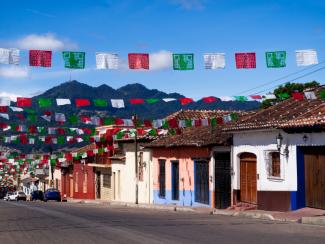
In the southernmost corner of Mexico, there is a beautiful, bountiful, and extraordinary place that is called Chiapas. One of Mexico’s 31 states, Chiapas is probably the greenest of them all, with so much lush vegetation and stunning landscapes over 74,415 square kilometres of land.
Within this beautiful setting live many different indigenous groups, such as the Tzotzils, Tzeltals, Ch’ol, Zoques, among many more. Chiapas has been their home for centuries and they have kept their culture, traditions, and languages alive despite all the many threats from outside of their communities. The sad fact is that these indigenous groups have suffered such oppression, injustice and racism over the years that their way of life is continuously under threat.
In 1994, a guerrilla group came down from the mountains of Chiapas and announced the beginning of a revolution: the Zapatista revolution. They demanded better rights for the indigenous population, in terms of work, health, education, dignity, and respect. They were tired of the way they had been treated by the Mexican government and society and their message to them was: ‘enough is enough.’
They wanted the world to know their suffering and to help them in their movement. For a while, they were a hot topic in the media and it seemed that everyone was talking about the Zapatistas. They were able to secure meetings and even agreements with government officials, which was promising to begin with, and then it became evident that nothing truly beneficial would come from any of this, as the government had no real intention to fulfil their promises.
So in 2003, the Zapatistas took matters into their own hands and established their own Zapatista communities in parts of Chiapas. Within these, they set up schools for the children, healthcare units, irrigation systems and even their own municipal governments, where members of the community could take turns in the official decision making of their home town. There are a few of these, and they still exist today. It is clear that the intentions of the Zapatistas were good and in the interest of the people’s wellbeing.
But the success of the movement is debatable. These Zapatista communities show that they have done very well in improving their living standards, and they also did well to raise global awareness of these issues. On the other hand, there are many people in Chiapas who disagree with the Zapatista movement or who argue that the way they carry things out is wrong. It seems that there is no serious fighting going on, but there is still tension and uneasiness within the state. What is obvious is that there is still much to be done to bring equality to the people of Chiapas – with or without the assistance of the Zapatistas.
Language level
Topics
Discussion
What else do you know about Mexico?
